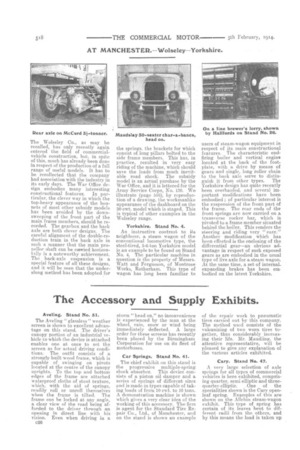THE COMMERCIAL MOTOR-5th February, 1 9 1 4. AT MANCHESTER.--Wolseley--Yorkshire.
Page 18

If you've noticed an error in this article please click here to report it so we can fix it.
The Wolseley Co., as may be recalled, has only recently again entered the field of commercialvehicle construction, but, in spite of this, much has already been done in respect of the production of a full range of useful models. It has to be recollected that the company had association with the industry in its early days. The War Office design embodies many interesting
constructional features. In particular, the clever way in which the top-heavy appearance of the bonnets of most other subsidy models has been avoided by the downsweeping of the front part of the main frame members, should be recorded. The gearbox and the back axle are both clever designs. The careful alignment of the double-reduction train in the back axle in such a manner that the main propeller E..whaft can be caaTied horizontally is a noteworthy achievement. The back-axle suspension is a special feature of all these designs, and it will be seen that the underslung method has been adopted for
the springs, the brackets for which consist a long pillars bolted to the side frame members. This has, in practice, resulted in very easy riding of the machine, which should save the loads from much inevitable road shock. The subsidy model is an actual purchase by the War Office, and it is lettered for the Army Service Corps, No. 120. We illustrate (page 516), by reproduction of a drawing, the workmanlike appearance of the dashboard on the 30-cwt. model which is staged. This is typical of other examples in the Wolseley range.
Yorkshire. Stand No. 4.
An instructive contrast to its neighbour, a steam wagon of the conventional locomotive type, the steel-tired, 5-6-ton Yorkshire model is an example to be found on Stand No. 4. The particular machine in question is the property of Messrs. Watt and Fergusson, of Montrose Works, Rotherham. This type of wagon has long been familiar to users of steam-wagon equipment in respect of its main constructional features. The characteristic endfiring boiler and vertical engine located at the back of the footplate, with a drive by means of gears and single, long roller chain to the back axle serve to distinguish it from other types. The Yorkshire design has quite recently been overhauled, and several important modifications have been embodied ; of particular interest is the suspension of the front part of the frame. The rear ends of the front springs are now carried on a transverse rocker bar, which is pivoted to a frame member situated behind the boiler. This renders the steering and riding very "easy." Another modification which has been effected is the enclosing of the differential gear—an obvious advantage in respect of such exposed gears as are embodied in the usual type of live axle for a steam wagon. At the same time, a set of internalexpanding brakes has been em. bodied on the latest Yorkshire.


































